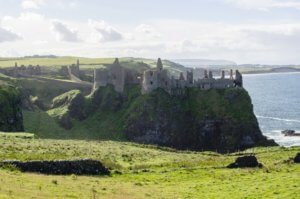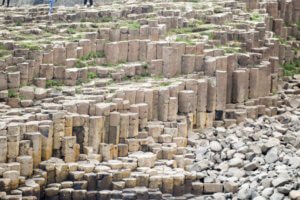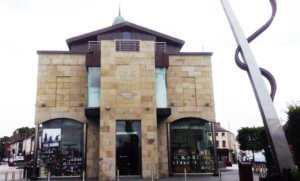More than just wild scenic beauty, Northern Ireland has a rich cultural history that is apparent once you visit the most important northern Ireland Landmarks. But how do you know which ones are worth your time?
Some of the world’s best travel writers have come up with a list of the top cultural and historical landmarks in Northern Ireland for you to visit on your next trip.
From ancient ruins to the end of the Troubles, discover the historic sites and vivid culture of this beautiful part of the United Kingdom.
Derry (Londonderry)
The city of Londonderry, more commonly known as Derry, dates back to the 6th century. It is the only completely walled city in Ireland making it a must-see for history lovers.

Walking around the city along the 400-year-old walls is the top thing to do in Derry, but the interesting sights don’t end there.
Within the walls, you’ll be immersed in history as you visit St. Columb’s Cathedral, Peace Bridge, and the Tower Museum, and take in the many wall murals depicting “The Troubles.”
For a taste of traditional as well as current local culture, head to the Craft Market.
The market is located on a re-creation of an 18th-century street and is full of vendor stalls, cafes, and restaurants so you can shop and eat in an open-air museum or take yourself on a food tour of Derry.
Derry makes a great stop on a road trip through Northern Ireland and the Wild Atlantic Way.
by Sarah from livedreamdiscover.com
Dunluce Castle
The ruins of Dunluce Castle in Northern Ireland boast one of the most impressive locations in the country, with a dramatic coastline situated at the base of the rocky outcrop and the North Atlantic Ocean sprawling out in front as far as the eye can see.

Dunluce Castle is thought to have been built by the MacQuillan family in around 1500 before being seized by Clan McDonnell in the 1550s.
Later, the area was built up into a town by the Earls of Antrim but was completely destroyed during the Irish Uprising of 1641.
Today, all that remains are some archaeological dig sites of the “lost town of Dunluce” and the ruins of the grand castle.
The castle is situated between the famous Royal Portrush Golf Club and the Giant’s Causeway, so it is a popular stop-off for those willing to learn more about Northern Ireland’s history.
by Chrysoula from allaboutcastles.com
Giant’s Causeway
The Giant’s Causeway is probably the most famous and most visited natural landmark in Northern Ireland.

Located an hour’s drive from Belfast in County Antrim, it is known to the Irish as the 8th wonder of the world and is a Unesco World Heritage Site. And no wonder, as it has a beautiful story behind it.
The legends say that the giant Finn McCool once used to live on this land.
One day he was challenged to fight by another Scottish giant, Benandonner, another giant who lived in Scotland, so he built a bridge and crossed the sea.
When he arrived in Scotland, he noticed that Benandonner was much bigger than him and there was no way he could win the fight, so he ran back home, scared.
Thinking that Benandonner is going to follow him, his wife had the idea to disguise Finn McCool as a baby.
The trick worked, as when Benandonner arrived and saw him, he got scared, thinking that if his baby is so big, Finn McCool must be the largest giant alive. He ran back to Scotland and destroyed the bridge behind him.
This is how the Giant’s Causeway was formed. On the opposite side of the Northern Channel, in Scotland, there are similar basalt columns, and it is possible that this was a factor in how this legend was born.
As much as we love legends, the truth is that the Giant’s Causeway was formed during an ancient volcanic fissure eruption, 50 to 60 million years ago.
The site is spectacular to visit, you are able to climb the perfectly shaped columns, which differ from a few centimeters to a couple of meters.
No matter what kind of Northern Ireland tour you are planning, you shouldn’t miss traveling along the Causeway coastal route to visit the Giant’s Causeway.
by Joanna from theworldinmypocket.com
Belfast
There was a brief time through a booming industrial economy in Belfast (engineering, shipbuilding, and the linen industry) when Belfast was the largest city on the entire island of Ireland.

Soon after came the Partition of Ireland (1922) when the island was split and Belfast became the most significant British settlement in Ireland and the capital of Northern Ireland.
To date, the local industrial economy and much of the tourism in Belfast is focussed around what is known as the Titanic Quarter, named after the ill-fated Titanic ship which was built along the Laganside stretch of Belfast. It is like walking around an open-air museum.
Otherwise, a good start for exploring Belfast’s local and regional history would be the Ulster Museum, an impressive and free visitor attraction located next to Belfast’s Botanic Gardens.
As well, city tours follow the ‘Troubles’ – the conflict in Northern Ireland that spilled over to London and the mainland UK.
Another great site to explore is the Ulster American Folk Park in nearby Cutra, which is a bit like a theme park village sharing life on the island in the twentieth century.
It is complete with rural farming landscapes (i.e. replica post offices, corner shops, and banks) and occasionally folk in period dress.
You can even try your hand at traditional trades like basketweaving and blacksmithing.
by Allan from bangorni.com
The Linen Museum
Irish Linen is highly prized across the world having adorned the tables of Royalty, the landed Gentry and the great Cruise Liners of the high seas, but where did it all begin?

Linen has been produced throughout Ireland for many centuries, but the City of Lisburn, near Belfast, can lay claim to being the birthplace of the Irish Linen Industry.
Many factors combined to initiate this revolution in Lisburn, but quite central was the arrival and settling of the Huguenots, French Protestants who fled persecution in France in the late 17th Century.
They brought great skill in Textiles and established factories growing the industry.
The Irish Linen Centre and Lisburn Museum is the perfect place to explore the Irish Linen Industry, a strong part of the culture of Northern Ireland.
The exhibition ‘Flax to Fabric: The Story of Irish Linen’ will take you on a historical journey, as well as an exploration of the skills and techniques developed to produce Linen including live demonstrations.
When you visit, look for the Lisburn Coat of Arms to spot the references to the Linen Industry. You should find a weaver’s shuttle, Fleur de Lys, and sprigs of flowering flax.
by Clotilde from aprincesstravellingwithtwins.com
Stormont Castle
The stunning grounds of the Stormont Estate and the Parliament Buildings which lie within are a must-visit site for anyone who delights in beautiful architecture.

The free guided tour of the Parliament Buildings takes about 45 minutes and runs twice a day during the week.
The architect, Sir Arnold Thornly, was knighted for his work by King George V.
The building has perfect symmetry, being 365ft wide – one for each day of the year and with six floors and six columns in the Assembly chamber – one for each county of Northern Ireland.
Ornate, carved ceilings made of marble are a feature of the Great Hall.
It is now home to the Northern Ireland Assembly – the authority that was established under the Good Friday agreement.
The building is an important location to visit for those interested in political history in order to appreciate the progress made in the conflict that plagued the country of Ireland in the latter half of the 20th century.
Stormont Estate is one of the stops on the Hop On Hop Off Bus Tour of Belfast which makes it easy to access if you’re traveling without a car.
by Emma from ourspanishlife.com
Titanic Belfast
Hands down, Titanic Belfast is by far the best museum experience in Northern Ireland. So, if you ever spend some time on the island of Ireland, this is a must-see attraction you need to visit.

Built on the former Harland & Wolff shipyard in Belfast where the RMS Titanic was built, it illuminates the ill-fated story of the most famous ship in the world.
In nine interactive galleries, visitors learn everything they ever wanted to learn about the world of the Titanic.
Dive into the cultural-historical background of Belfast at the beginning of the 20th century, explore the world of the shipyard (here you can ride in a theme park-like minicar around a replica of the shipyard while you get interactive insights into the workers’ daily chores).
You can read touching individual stories of passengers and find out more about the fascinating legacy and myth of the Titanic.
An absolute highlight is also the glass floor at the end of the exhibition, which lets you explore the wreck from a fish-eye view.
This museum really engages all your senses and leaves you with a lasting impression of this important historical site.
by Emer and Nils from letsgoireland.com
Glenarm Castle
Glenarm Castle in Northern Ireland sits on one of the few private family country estates that’s open to the public.

The McDonnell family has been at Glenarm for nearly 600 years and prior to taking up residence here they lived in the now-ruined Dunluce Castle.
Entrance into the castle itself is, unfortunately, not so easy. The castle is only open to the public for a few days a year, for special festivals, or by pre-arranged group tours.
However, some of the grounds around the castle are open from March to November.
Visitors can have a variety of experiences here: explore the beautiful walled garden, walk the Castle Trail, have lunch in the Tearoom, or pick up a gift at the Byre Shop or the Shambles Workshop.
It’s also possible to visit the estate when it holds special events during the year including music, food, family, and Christmas festivals.
The Glenarm visitor’s center offers guided walks and information on what’s happening at the Castle.
by Sarah from livedreamdiscover.com
The Troubles Murals
The Troubles, as the war in Northern Ireland, is now known, was a destructive and divisive time in both Irish and UK History.
Both sides have suffered great losses to both military and civilian life and the scars are still healing.

The Shankill Road area is loyalist, they want the six counties of Northern Ireland to remain in the United Kingdom.
The murals on Shankill Road are predominantly blue, red, and white, the colors of the Union Jack. The imagery here centers around the Ulster Volunteer Force as well as the deaths of many innocents.
The Falls Road is the Republican area, they believe in a united Ireland and in returning the six counties to the Republic of Ireland.
These murals speak more to the sacrifice of the ten hunger strikers in 1981 and stolen land across the world, including Palestine and the Basque country.
I visited with my Irish husband – he’s from Cork – and the Shankill Road murals were physically painful for him to see.
No matter what side you fall on, a visit to the murals on Falls and Shankill Roads in Belfast will give you pause to think. You can visit on foot but a guided tour would give a much better background.
By Emma at mumsmoney.com
Saint Patrick’s Grave and Down Cathedral
A visit to Down Cathedral and Saint Patrick’s Grave in Northern Ireland is a must for any history lover.

An easy day trip from Belfast and a ferry ride across Strangford Lough brings you to County Down and Downpatrick parish in the province of Ulster.
Across the Quoile River are wonderful views of Downpatrick mound with its cathedral atop Cathedral Hill.
Surrounded by a graveyard, the atmospheric cathedral has significant stained glass windows a large High Cross in front.
This is a replica of the actual High Cross that is 1000 years old and you can see it in the museum on your visit.
The original church was built in the 12th century and is dedicated to the Holy Trinity. Fire, earthquakes, and waves of destroyers have visited destruction upon Down Cathedral.
Major restorations began in the late 1700s and have been ongoing. Much of the 15th-century chancel remains.
The real attraction for coming here, however, is to see the grave of St Patrick. Saint Patrick is one of the two patron saints of Ireland and is believed to have died around 461.
He is known as the Apostle of Ireland and is credited with spreading Christianity in Ireland. He gathered disciples and built churches throughout the island.
The ancient granite stone was lifted onto his grave in 1900 to prevent graverobbing. Saint Patrick’s grave is also the gravesite of Saint Brigid and Saint Columcille and together they are the three most important saints in Irish religious history.
Other Northern Island Landmarks Worth Visiting
Any list of Northern Ireland landmarks is full to the brim with curious and beautiful sites.
If you are planning a visit to Northern Ireland, here is a list of the other most popular landmarks and places of interest and natural beauty that are also worth trying to fit into your itinerary:
- Crumlin Road Gaol
- Marble Arch Caves
- Rede Rope Bridge (the Carrick-a-Rede rope bridge)
- Grand Opera House
- Carrickfergus Castle
- Mount Stewart
- Blarney Castle
- Mountains of Mourne
- Antrim Coast and Glens of Antrim
Keep Planning Your Trip to the UK
- 10 Best Northern Ireland Landmarks for History and Culture
- Self-guided day trip to Down Cathedral and Saint Patrick’s Grave
- 12 Best Cultural and Historical Places in England to Visit
- Best Scotland Landmarks for History and Culture
- Why You Should See Newcastle’s Angel of the North Statue
- 65 Fun Facts about the Angel of the North, England
- Top 12 Things to Do in Allendale Northumberland
- Amazing Standing Stones of Callanish
- Isle of Lewis: Mystery and History
- Guide to the 3 Best Newcastle Christmas Markets for 2023 in Newcastle UK
